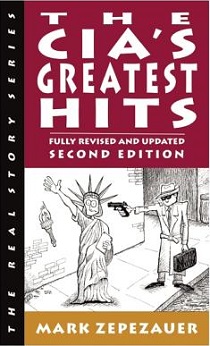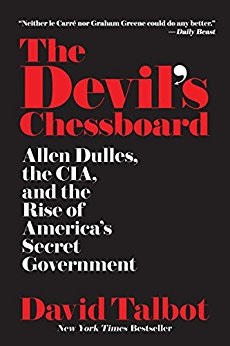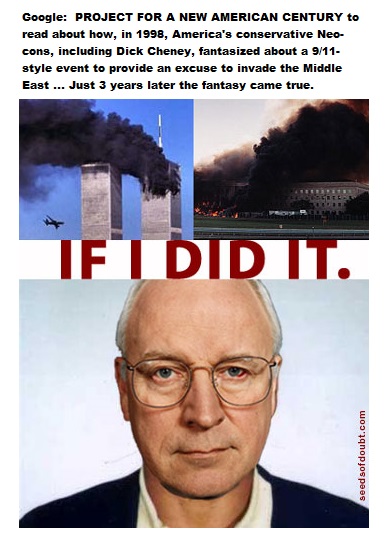"No assassination instructions should ever be written or recorded. Decision and instructions [regarding assassination] should be confined to an absolute minimum of persons. For secret assassination ... the contrived accident is the most effective technique. When successfully executed, it causes little excitement and is only casually investigated."--A Study of Assassination, a training manual written by the CIA and distributed to agents and operatives at the time of the Agency's 1954 covert coup in Guatemala, which ousted Guatemala's democratically elected president, Jacobo Arbenz Guzman. "In the late 1970s, I also participated in the Senate's investigation of the CIA and our intelligence community. We discovered efforts to assassinate foreign leaders. We also tentatively pursued inquiries into the possibility that plots had been laid to assassinate our leaders. All part of the same Cold War, a Cold War that existed from early memory."--former U.S. Senator Gary Hart, Russia Shakes the World: The Second Russian Revolution and Its Impact on the World "They are the most ruthless motherf---ers there are and if they want to get somebody, they will. They will do their own people up."--David Sanchez Morales, talking about the CIA, (Morales was the former Chief of Operations at the CIA station in Miami -- JM/WAVE -- and a consultant to the Deputy Director of the Joint Chiefs), cited by Gaeton Fonzi, The Last Investigation On April 3, 1996, Commerce Secretary Ron Brown and 34 others were killed when their Air Force Boeing 737 crashed into a mountainside in Croatia. One day after the crash, before any real investigation had begun, Defense Secretary William Perry told the Associated Press that the plane crash was "a classic sort of accident that good instrumentation should be able to prevent." The Air Force soon agreed and, in its ensuing investigation, determined that the tragic event was due to navigational error. Since that time, certain anomalies have come to light regarding the crash:
Planning a Political Assassination For assassins desiring to get rid of a political opponent, a plane crash would appear to be an ideal method. In plane crashes, evidence of sabotage is often destroyed, or at least can be made to appear so during any subsequent investigation. Also, the public knows that accidents do happen, and that planes sometimes do crash all by themselves. However, conspirators have to be aware that even the most trusting citizen may occasionally experience misgivings, especially regarding the death of a powerful politician embroiled in controversy. Hence, to cover all bases, it would be useful (from a conspiratorial planner's viewpoint) to incorporate certain elements into a plan that would deflect attention from the conspirators and in the direction of someone else, ideally an enemy. This kind of diversionary planning may have occurred in the case of the assassination of President Kennedy. Consider a 2001 Gallup poll which revealed that 81 percent of Americans don't believe the Warren Commission's lone nut (Oswald did it) version of the assassination. Among the 81 percent, there are those who think that Oswald was a patsy, set up by some group (or agency) to take the fall. Over the years, much evidence has emerged that suggests right-wing planning and involvement by elements of the CIA in the assassination (i.e., that the assassination was, in essence, a CIA-planned conspiracy). Assume for a moment that CIA conspirators orchestrated the Kennedy assassination, and that Oswald was the patsy. It would stand to reason that the conspirators, in setting up the patsy, would want to divert attention from themselves, should the public ever come to doubt the lone-nut, official version of the assassination. Thus it may be regarded as good planning that Oswald was portrayed not just as a lone-nut, but as a Communist as well. In this way, any suspicion of a conspiracy would immediately point toward left-wing rather than right-wing involvement (a desirable outcome from the conspirators' point of view). Likewise, if right-wing forces were responsible for Ron Brown's plane crash, they would probably want suspicion to focus on one of their enemies -- someone like President Bill Clinton. Spinning a Conspiracy Theory Soon after Ron Brown's death, a right-wing billionaire, Richard Mellon Scaife -- heir to the Mellon family banking fortune -- began to promote a conspiracy theory involving President Clinton. Steve Kangas, a journalist and former intelligence analyst, gives some background on Scaife:
At Forum World Features, Scaife conducted what his CIA friend, Frank Barnett calls "political warfare." Barnett explains:
Scaife has carried his political warfare campaign into the present day. His instrument of dissemination is no longer a foreign news service. Instead Scaife utilizes two Internet websites (NewsMax and WorldNetDaily), a newspaper (Pittsburgh Tribune-Review), along with conservative foundations and think tanks. Steve Kangas writes:
Scaife's hired gun, Christopher Ruddy has applied the Scaife/Barnett technique of political warfare -- "one part persuasion and two parts deception" -- to the Ron Brown case. Ruddy was persuasive in arguing that there were some strange and suspicious aspects to the plane crash. Ruddy was also persuasive when he pointed out that Ron Brown had been involved in various controversies during his term as Commerce Secretary. However, Ruddy was deceptive when he omitted the fact that the biggest controversy had to do with Ron Brown's fight with the military establishment. The Fight Over Exports Ron Brown's struggles with the hawks in the military and intelligence agencies began almost from the moment that he assumed the post of Commerce Secretary. According to an Associated Press article: "With the Cold War over, Brown believed the United States no longer should sacrifice economic interests to other foreign policy goals and he used his close friendship with Clinton to push a business agenda inside the administration.... He succeeded in battles with the Defense Department in loosening Cold War-era export controls that American companies had long complained severely limited their ability to sell high-technology products such as computer and telecommunications equipment."(4) Ron Brown was not alone in his quest to ease export restrictions. Brown's allies even included conservative organizations, like the American Chamber of Commerce, which stated in its White Paper: "Experience has shown ... that unilateral export controls are ineffective, except where the United States may have a pronounced lead over the rest of the world.... [With export controls] U.S. companies are put at a significant disadvantage vis-a-vis their foreign competitors, without achieving the desired effect of blocking access to technology."(5) However, the military establishment remained unconvinced. When the Clinton administration proposed that primary control over the export of commercial satellites be transferred from the State Department to Ron Brown's Commerce Department, the military balked. In a memo dated September 22, 1995, the Pentagon and U.S. intelligence agencies are on record as rejecting the administration's plan to transfer authority to Commerce. Also opposed was Secretary of State Warren Christopher.(6) Attacks on the Commerce Department Early in 1995, in what some might regard as a preemptive strike to undermine Ron Brown's position at the Commerce Department, "Allegations arose ... concerning improprieties related to [Brown's] financial transactions. In particular, there were media reports that Secretary Brown ... failed to disclose required information about First International, a company he owned with a business associate, Nolanda S. Hill."(7) In July 1995, an independent counsel was chosen to investigate these charges. As the independent counsel probe got underway, additional allegations would soon be leveled against the Commerce Secretary. That same year, congressional Republicans would draft legislation to dismantle the Department of Commerce. The Republicans would fail in this endeavor, but not for lack of trying. According to Gary Hufbauer, a trade expert, "The force of Brown's personality was one of the major factors that saved the department."(8) On March 14, 1996 -- in defiance of the military and intelligence agencies -- the Clinton administration transferred control of satellite sales from the State Department to Ron Brown's Commerce Department. This may have been the fateful decision that sprung the CIA hawks into action. Twenty days later Ron Brown would lose his life. Assassinations' Prime Suspect Whenever an American politician dies in a suspicious plane crash, the skeptical and discerning citizen will look first in the direction of the CIA -- an organization whose modus operandi in the political realm includes heavy-handed techniques like sabotage, assassinations, and coups. The CIA almost certainly maintains lists of saboteurs and assassins that have worked with it in various campaigns over the years, and CIA operatives could conceivably put together an assassination plan by placing a few phone calls. In all likelihood, it will never be conclusively known whether the CIA or some other party was responsible for sabotaging Ron Brown's plane. However, given the circumstances surrounding the plane crash, the CIA has to be at the top of the suspect list. The CIA School of Assassination at Fort Bragg Notes: 1. Steve Kangas, "The Origins of the Overclass," Liberalism Resurgent, Website: http://home.att.net/~Resurgence/L-overclass.html 2. Frank R. Barnett, "A Proposal for Political Warfare," Military Review, March 1961. 3. Kangas. 4. Associated Press, "Now Who Will Speak Up for Capitalism in the Administration?," The Minnesota Daily, April 8, 1996, sec. World/Nation. 5. "U.S. Export Controls," 2001 White Paper: American Business in China (The American Chamber of Commerce Publications, February 2001). 6. Bill Gertz, "Satellite Export Concerns Not New," The Washington Times National Weekly Edition, June 11-17, 1998. 7. United States Court of Appeals for the District of Columbia Circuit in Regard to Ronald H. Brown: (Filed August 29, 2000), pp. 3-4. 8. Associated Press, "Now Who Will Speak Up for Capitalism in the Administration?". Links: The Right-Wing Shadow Government - Treason on the Right Nixon, Watergate, and the JFK Assassination Kennedy Curse or a Right-Wing Vendetta? CIA Operative Gen. Ed Lansdale Photographed in Dealey Plaza The Garrison Investigation Jim Garrison--1967 Lecture (Audio) Oliver Stone Answers Audience Questions Arlen Specter and the Single Bullet Theory Hale Boggs - Warren Commission Member and Critic The Intimidation of Dealey Plaza Witnesses The Senator who Suspected a JFK Conspiracy Lee Harvey Oswald — The Patsy Did Militarists Sabotage Gary Power's U-2 Plane? J. Edgar Hoover - Blackmailed by the Mob Gerald Ford's Role in the JFK Assassination Cover-up The Enemy Within - The Pentagon Plan to Terrorize U.S. Citizens and Blame Cuba The Plane that Never Hit the Pentagon Vice President Dick Cheney's Stand-Down Order on 9/11 Cheney's Proposal to Dress Up Navy Seals as Iranians and Shoot at Them Did a Neocon Gang Send Anthrax Letters to Senators Daschle and Leahy to Intimidate Them and Thwart a Congressional Investigation of 9/11? 'October Surprise' Plane Crashes (Election Eve Terror) Using Disaster Drills as a Cover to Stage False Flag Terror Attacks CIA Assassin David Morales Photographed at the Ambassador Hotel General Curtis LeMay - Demented Cold Warrior The October Surprise The CIA School of Assassination at Fort Bragg A Timeline of CIA Meddling in Latin America Trickle Down Economics - The Big Con "Body of Secrets" - Attack on the USS Liberty CIA Infiltration and Manipulation of the Mass Media CIA Instructions to Media Assets Tapes Reveal Nixon Prolonged Vietnam War for Political Reasons George H. W. Bush -- Was He Part of It? Fonda was Right and Bush was Lying Notable JFK Conspiracy Theorists: LBJ, Nixon and J. Edgar Hoover The Reagan Years
|


